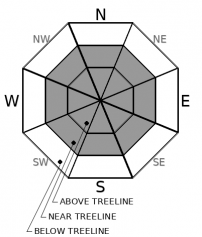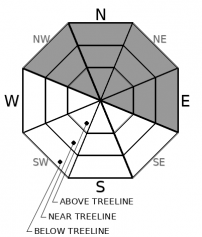| Tuesday | Tuesday Night | Wednesday | |
|---|---|---|---|
| Weather: | Sunny. Snow levels below 7000 feet. Chance of precipitation is 0%. | Clear then becoming partly cloudy. Snow levels below 7000 feet. Chance of precipitation is 0%. | Sunny. Snow levels below 7000 feet increasing to 7500 feet in the afternoon. Chance of precipitation is 0%. |
| Temperatures: | 32 to 37 deg. F. | 16 to 22 deg. F. | 38 to 43 deg. F. |
| Mid Slope Winds: | Gusts up to 35 mph decreasing to 25 mph in the afternoon. | Light winds. | Light winds. |
| Expected snowfall: | No accumulation. | SWE = none. | No accumulation. | SWE = none. | No accumulation. | SWE = none. |
| Tuesday | Tuesday Night | Wednesday | |
|---|---|---|---|
| Weather: | Sunny. Snow levels below 7000 feet. Chance of precipitation is 0%. | Clear then becoming partly cloudy. Snow levels below 7000 feet. Chance of precipitation is 0%. | Sunny. Snow levels below 7000 feet increasing to 7500 feet in the afternoon. Chance of precipitation is 0%. |
| Temperatures: | 31 to 36 deg. F. | 18 to 23 deg. F. | 37 to 42 deg. F. |
| Ridge Top Winds: | Northeast 15 to 30 mph. Gusts up to 70 mph decreasing to 50 mph in the afternoon. | Northeast 15 to 25 mph with gusts to 45 mph. | Northwest 15 to 25 mph with gusts to 45 mph. |
| Expected snowfall: | No accumulation. | SWE = none. | No accumulation. | SWE = none. | No accumulation. | SWE = none. |


























